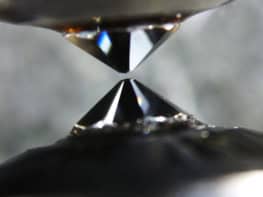Scientists at IBM have made the fastest graphene transistor to date. The device operates at frequencies as high as 26 GHz and could find use in wireless communications equipment.
A transistor’s operation speed depends on the size of the device — smaller devices can run faster — and the speed at which electrons travel in it. This size dependence has been one of the major driving forces for making ever smaller silicon transistors. However, the challenges of making practical silicon transistors smaller than about 40 nm will ultimately put the brakes on future speed-ups.
Some researchers believe that the ‘wonder material’ graphene — which is a sheet of carbon just one atom thick — could offer a way forward. As well as being extremely thin and a semiconductor, electrons move through graphene at extremely high speeds. This is because they behave like relativistic particles that have no rest mass. Because of this, and other unusual physical properties, graphene is often touted to replace silicon as the electronic material of choice and might be used to make faster transistors than any that exist today.
Real progress since 2004
Yu-Ming Lin and colleagues at IBM’s T J Watson Research Center have now demonstrated graphene transistors exhibiting a cut-off frequency of 26 GHz, the highest frequency reported for graphene so far (arXiv 0812.1586). While this is about 10 times slower than the fastest silicon transistor, it is remarkable progress because graphene was only discovered in 2004, whereas the silicon transistor has been around for over 50 years and has benefited from decades of intense research and development.
The team also revealed for the first time that the operation frequency of these devices increases as gate length size decreases. The value of 26 GHz was found for transistors with a gate length of 150 nm. This result provides guidance for improving the performance of graphene devices, said Lin.
The team also found that the devices behave like conventional field-effect transistors — that is the measured current gain decreases with frequency, f, according to 1/f. This will be important for modelling graphene transitors and for designing circuits based on graphene devices, explained Lin.
Scaling the gate length down
Most graphene devices made previously were back-gated, using a 300 nm thick silicon dioxide layer as the gate dielectric. Lin and colleagues’ device is different because it employs a top-gate dielectric structure, made of aluminium oxide, which allows the transistor to operate at lower voltages. Scaling the gate length down to 150 nm, from tens of micrometres previously, also contributes to the high cut-off frequency of 26 GHz, Lin told physicsworld.com.
The IBM researchers now hope to optimize the gate dielectric materials to further improve the electrical properties of the final devices and make radio-frequency circuits from the structures. They even reckon that graphene transistors operating at terahertz frequencies could be made in devices that have a gate length of just 50 nm. “We also plan to demonstrate graphene transistors made by other approaches,” added Lin.



